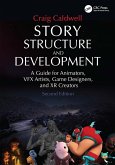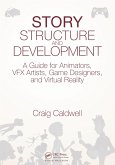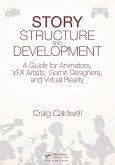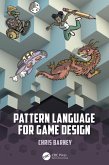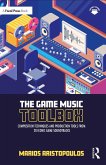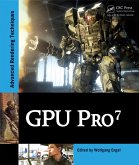Craig Caldwell
Story Structure and Development (eBook, PDF)
A Guide for Animators, VFX Artists, Game Designers, and XR Creators
51,95 €
51,95 €
inkl. MwSt.
Erscheint vor. 25.03.25

26 °P sammeln
51,95 €
Als Download kaufen

51,95 €
inkl. MwSt.
Erscheint vor. 25.03.25

26 °P sammeln
Jetzt verschenken
Alle Infos zum eBook verschenken
51,95 €
inkl. MwSt.
Erscheint vor. 25.03.25
Alle Infos zum eBook verschenken

26 °P sammeln
Unser Service für Vorbesteller - Ihr Vorteil ohne Risiko:
Sollten wir den Preis dieses Artikels vor dem Erscheinungsdatum senken, werden wir Ihnen den Artikel bei der Auslieferung automatisch zum günstigeren Preis berechnen.
Sollten wir den Preis dieses Artikels vor dem Erscheinungsdatum senken, werden wir Ihnen den Artikel bei der Auslieferung automatisch zum günstigeren Preis berechnen.
Craig Caldwell
Story Structure and Development (eBook, PDF)
A Guide for Animators, VFX Artists, Game Designers, and XR Creators
- Format: PDF
- Merkliste
- Auf die Merkliste
- Bewerten Bewerten
- Teilen
- Produkt teilen
- Produkterinnerung
- Produkterinnerung
- Weitere 6 Ausgaben:
- Gebundenes Buch
- Broschiertes Buch
- Broschiertes Buch
- eBook, ePUB
- eBook, ePUB
- eBook, PDF

Bitte loggen Sie sich zunächst in Ihr Kundenkonto ein oder registrieren Sie sich bei
bücher.de, um das eBook-Abo tolino select nutzen zu können.
Hier können Sie sich einloggen
Hier können Sie sich einloggen
Sie sind bereits eingeloggt. Klicken Sie auf 2. tolino select Abo, um fortzufahren.

Bitte loggen Sie sich zunächst in Ihr Kundenkonto ein oder registrieren Sie sich bei bücher.de, um das eBook-Abo tolino select nutzen zu können.
This book provides a clear and practical approach to understanding the essentials of storytelling. This book distills fundamental elements, principles, and structures, explicitly tailored for animators, game designers, VFX artists, and XR creators, so they can seamlessly integrate these concepts into their work.
- Geräte: PC
- mit Kopierschutz
- eBook Hilfe
Andere Kunden interessierten sich auch für
![Story Structure and Development (eBook, ePUB) Story Structure and Development (eBook, ePUB)]() Craig CaldwellStory Structure and Development (eBook, ePUB)51,95 €
Craig CaldwellStory Structure and Development (eBook, ePUB)51,95 €![Story Structure and Development (eBook, PDF) Story Structure and Development (eBook, PDF)]() Craig CaldwellStory Structure and Development (eBook, PDF)55,95 €
Craig CaldwellStory Structure and Development (eBook, PDF)55,95 €![Story Structure and Development (eBook, ePUB) Story Structure and Development (eBook, ePUB)]() Craig CaldwellStory Structure and Development (eBook, ePUB)55,95 €
Craig CaldwellStory Structure and Development (eBook, ePUB)55,95 €![Dramatic Storytelling and Narrative Design (eBook, PDF) Dramatic Storytelling and Narrative Design (eBook, PDF)]() Ross BergerDramatic Storytelling and Narrative Design (eBook, PDF)51,95 €
Ross BergerDramatic Storytelling and Narrative Design (eBook, PDF)51,95 €![Pattern Language for Game Design (eBook, PDF) Pattern Language for Game Design (eBook, PDF)]() Christopher BarneyPattern Language for Game Design (eBook, PDF)59,95 €
Christopher BarneyPattern Language for Game Design (eBook, PDF)59,95 €![The Game Music Toolbox (eBook, PDF) The Game Music Toolbox (eBook, PDF)]() Marios AristopoulosThe Game Music Toolbox (eBook, PDF)40,95 €
Marios AristopoulosThe Game Music Toolbox (eBook, PDF)40,95 €![GPU Pro 7 (eBook, PDF) GPU Pro 7 (eBook, PDF)]() GPU Pro 7 (eBook, PDF)94,95 €
GPU Pro 7 (eBook, PDF)94,95 €-
-
-
This book provides a clear and practical approach to understanding the essentials of storytelling. This book distills fundamental elements, principles, and structures, explicitly tailored for animators, game designers, VFX artists, and XR creators, so they can seamlessly integrate these concepts into their work.
Dieser Download kann aus rechtlichen Gründen nur mit Rechnungsadresse in A, B, BG, CY, CZ, D, DK, EW, E, FIN, F, GR, HR, H, IRL, I, LT, L, LR, M, NL, PL, P, R, S, SLO, SK ausgeliefert werden.
Produktdetails
- Produktdetails
- Verlag: Taylor & Francis eBooks
- Seitenzahl: 222
- Erscheinungstermin: 25. März 2025
- Englisch
- ISBN-13: 9781040264416
- Artikelnr.: 73301838
- Verlag: Taylor & Francis eBooks
- Seitenzahl: 222
- Erscheinungstermin: 25. März 2025
- Englisch
- ISBN-13: 9781040264416
- Artikelnr.: 73301838
- Herstellerkennzeichnung Die Herstellerinformationen sind derzeit nicht verfügbar.
Craig Caldwell is USTAR (Utah Science Technology and Research) professor in digital media at the University of Utah. Having worked for Walt Disney Feature Animation and Electronic Arts games he has extensive experience in the industry approach to creating animation and games. Caldwell has been a co-founder and arts director for one of the top-ranked interactive games programs, Entertainment Arts and Engineering (EAE - University of Utah) with its numerous award-winning games. He has served as head of the largest film school in Australia-Griffith Film School, Griffith University, as well as chair of the Media Arts Department and associate director of the New Media Center at University of Arizona; as well as having been selected as a DeTao Master, Institute of Animation and Creative Content on the SIVA campus, Shanghai, China. Caldwell speaks frequently on story at major conferences such as SIGGRAPH, FMX, Mundos Digitales, industry, and universities. He earned his PhD from the Advanced Computing Center for Art and Design, Ohio State University.
Part 1 - Story Structure (Plot)
Chapter 1 Plot - the structure
What is a Dramatic Story?
Plot... what is it?
3 Act Structure
Multiple Acts
Plot Shapes
Plot Structures - The Short
Structural Comparisons
What do all plots have in common?
References
Chapter 2 Setup Act I (beginning)
Types of Setup
The Opening Image
Exposition (what does the audience need to know?)
Show Don't Tell Rule
Inciting Incident (starting the story)
What's at Stake (why an audience cares)
Story Questions (keeps the audiences watching)
End of Act I - New Story World
References
Chapter 3 Conflict Act II (the middle)
What happens in the Middle?
Increasing Conflict
Types of Conflict
Turning Points/Reversals
Cause and Effect (connected events)
End of Act II - Crisis
References
Chapter 4 Resolution Act III (end)
Endings - for the Viewer
Climax
Resolution
Meaning
References
Chapter 5 Plot Driven Stories
Story Genres
Story Types
Only a few basic Plots
References
Part 2 - Story Principles
Chapter 6 Story Components
Is Conflict necessary?
Premise - What is the Story about?
Theme - What does it mean?
Emotion - Purpose of dramatic story
The Setting (situation)
References
Chapter 7 Story Techniques
Narrative Questions
Surprise
Suspense
Comedy
Foreshadowing - Creating anticipation
References
Chapter 8 Interactive Narratives
Why Story in Games/XR?
Story versus Narrative
World Storytelling - Narrative as Story World
Immersive Story(telling)?
AI & Human Storytelling?
References
Part 3 - Bringing Characters to Life
Chapter 9 Character
Character - Why do we watch?
Archetypes vs. Stereotypes
Create Finding your Characters
Backstory vs. Character Profile
Identification/Empathy
Love your Characters
Villains
References
Chapter 10 Character Motivations
What does a character want?
Need - What a character really, really wants
Conflict reveals character
Character Flaws (Fatal)
Setting as Character
References
Chapter 11 Character Driven Stories
Character Stories
Fear - the Inner Journey
Choices - it is why we watch
Types of Change
Character Arc
Unity of opposites
References
Part 4 - Storytelling (the development)
Chapter 12 Generating Ideas
Brainstorming Ideas
Three Types of Research
Asking... What If?
Clichés - good or bad?
Point of View - Whose story is it?
References
Chapter 13 Development
The Development process
Borrow, Adapt, Steal
Problems are at the beginning
Know your Ending
Dialogue - its functions
Making the story... Short
References
Chapter 14 Viewer (Audience/Player)
Meeting Viewer's Expectations
Who know What? When?
Gaps - the unexpected
Believability
Are Coincidences OK?
References
Chapter 15 Subverting the Story Formula
Disrupting Story Expectations
Breaking Genre Tropes & Plots
Hybrid Genres
Eastern vs. Western Storytelling
References
Chapter 1 Plot - the structure
What is a Dramatic Story?
Plot... what is it?
3 Act Structure
Multiple Acts
Plot Shapes
Plot Structures - The Short
Structural Comparisons
What do all plots have in common?
References
Chapter 2 Setup Act I (beginning)
Types of Setup
The Opening Image
Exposition (what does the audience need to know?)
Show Don't Tell Rule
Inciting Incident (starting the story)
What's at Stake (why an audience cares)
Story Questions (keeps the audiences watching)
End of Act I - New Story World
References
Chapter 3 Conflict Act II (the middle)
What happens in the Middle?
Increasing Conflict
Types of Conflict
Turning Points/Reversals
Cause and Effect (connected events)
End of Act II - Crisis
References
Chapter 4 Resolution Act III (end)
Endings - for the Viewer
Climax
Resolution
Meaning
References
Chapter 5 Plot Driven Stories
Story Genres
Story Types
Only a few basic Plots
References
Part 2 - Story Principles
Chapter 6 Story Components
Is Conflict necessary?
Premise - What is the Story about?
Theme - What does it mean?
Emotion - Purpose of dramatic story
The Setting (situation)
References
Chapter 7 Story Techniques
Narrative Questions
Surprise
Suspense
Comedy
Foreshadowing - Creating anticipation
References
Chapter 8 Interactive Narratives
Why Story in Games/XR?
Story versus Narrative
World Storytelling - Narrative as Story World
Immersive Story(telling)?
AI & Human Storytelling?
References
Part 3 - Bringing Characters to Life
Chapter 9 Character
Character - Why do we watch?
Archetypes vs. Stereotypes
Create Finding your Characters
Backstory vs. Character Profile
Identification/Empathy
Love your Characters
Villains
References
Chapter 10 Character Motivations
What does a character want?
Need - What a character really, really wants
Conflict reveals character
Character Flaws (Fatal)
Setting as Character
References
Chapter 11 Character Driven Stories
Character Stories
Fear - the Inner Journey
Choices - it is why we watch
Types of Change
Character Arc
Unity of opposites
References
Part 4 - Storytelling (the development)
Chapter 12 Generating Ideas
Brainstorming Ideas
Three Types of Research
Asking... What If?
Clichés - good or bad?
Point of View - Whose story is it?
References
Chapter 13 Development
The Development process
Borrow, Adapt, Steal
Problems are at the beginning
Know your Ending
Dialogue - its functions
Making the story... Short
References
Chapter 14 Viewer (Audience/Player)
Meeting Viewer's Expectations
Who know What? When?
Gaps - the unexpected
Believability
Are Coincidences OK?
References
Chapter 15 Subverting the Story Formula
Disrupting Story Expectations
Breaking Genre Tropes & Plots
Hybrid Genres
Eastern vs. Western Storytelling
References
Part 1 - Story Structure (Plot)
Chapter 1 Plot - the structure
What is a Dramatic Story?
Plot... what is it?
3 Act Structure
Multiple Acts
Plot Shapes
Plot Structures - The Short
Structural Comparisons
What do all plots have in common?
References
Chapter 2 Setup Act I (beginning)
Types of Setup
The Opening Image
Exposition (what does the audience need to know?)
Show Don't Tell Rule
Inciting Incident (starting the story)
What's at Stake (why an audience cares)
Story Questions (keeps the audiences watching)
End of Act I - New Story World
References
Chapter 3 Conflict Act II (the middle)
What happens in the Middle?
Increasing Conflict
Types of Conflict
Turning Points/Reversals
Cause and Effect (connected events)
End of Act II - Crisis
References
Chapter 4 Resolution Act III (end)
Endings - for the Viewer
Climax
Resolution
Meaning
References
Chapter 5 Plot Driven Stories
Story Genres
Story Types
Only a few basic Plots
References
Part 2 - Story Principles
Chapter 6 Story Components
Is Conflict necessary?
Premise - What is the Story about?
Theme - What does it mean?
Emotion - Purpose of dramatic story
The Setting (situation)
References
Chapter 7 Story Techniques
Narrative Questions
Surprise
Suspense
Comedy
Foreshadowing - Creating anticipation
References
Chapter 8 Interactive Narratives
Why Story in Games/XR?
Story versus Narrative
World Storytelling - Narrative as Story World
Immersive Story(telling)?
AI & Human Storytelling?
References
Part 3 - Bringing Characters to Life
Chapter 9 Character
Character - Why do we watch?
Archetypes vs. Stereotypes
Create Finding your Characters
Backstory vs. Character Profile
Identification/Empathy
Love your Characters
Villains
References
Chapter 10 Character Motivations
What does a character want?
Need - What a character really, really wants
Conflict reveals character
Character Flaws (Fatal)
Setting as Character
References
Chapter 11 Character Driven Stories
Character Stories
Fear - the Inner Journey
Choices - it is why we watch
Types of Change
Character Arc
Unity of opposites
References
Part 4 - Storytelling (the development)
Chapter 12 Generating Ideas
Brainstorming Ideas
Three Types of Research
Asking... What If?
Clichés - good or bad?
Point of View - Whose story is it?
References
Chapter 13 Development
The Development process
Borrow, Adapt, Steal
Problems are at the beginning
Know your Ending
Dialogue - its functions
Making the story... Short
References
Chapter 14 Viewer (Audience/Player)
Meeting Viewer's Expectations
Who know What? When?
Gaps - the unexpected
Believability
Are Coincidences OK?
References
Chapter 15 Subverting the Story Formula
Disrupting Story Expectations
Breaking Genre Tropes & Plots
Hybrid Genres
Eastern vs. Western Storytelling
References
Chapter 1 Plot - the structure
What is a Dramatic Story?
Plot... what is it?
3 Act Structure
Multiple Acts
Plot Shapes
Plot Structures - The Short
Structural Comparisons
What do all plots have in common?
References
Chapter 2 Setup Act I (beginning)
Types of Setup
The Opening Image
Exposition (what does the audience need to know?)
Show Don't Tell Rule
Inciting Incident (starting the story)
What's at Stake (why an audience cares)
Story Questions (keeps the audiences watching)
End of Act I - New Story World
References
Chapter 3 Conflict Act II (the middle)
What happens in the Middle?
Increasing Conflict
Types of Conflict
Turning Points/Reversals
Cause and Effect (connected events)
End of Act II - Crisis
References
Chapter 4 Resolution Act III (end)
Endings - for the Viewer
Climax
Resolution
Meaning
References
Chapter 5 Plot Driven Stories
Story Genres
Story Types
Only a few basic Plots
References
Part 2 - Story Principles
Chapter 6 Story Components
Is Conflict necessary?
Premise - What is the Story about?
Theme - What does it mean?
Emotion - Purpose of dramatic story
The Setting (situation)
References
Chapter 7 Story Techniques
Narrative Questions
Surprise
Suspense
Comedy
Foreshadowing - Creating anticipation
References
Chapter 8 Interactive Narratives
Why Story in Games/XR?
Story versus Narrative
World Storytelling - Narrative as Story World
Immersive Story(telling)?
AI & Human Storytelling?
References
Part 3 - Bringing Characters to Life
Chapter 9 Character
Character - Why do we watch?
Archetypes vs. Stereotypes
Create Finding your Characters
Backstory vs. Character Profile
Identification/Empathy
Love your Characters
Villains
References
Chapter 10 Character Motivations
What does a character want?
Need - What a character really, really wants
Conflict reveals character
Character Flaws (Fatal)
Setting as Character
References
Chapter 11 Character Driven Stories
Character Stories
Fear - the Inner Journey
Choices - it is why we watch
Types of Change
Character Arc
Unity of opposites
References
Part 4 - Storytelling (the development)
Chapter 12 Generating Ideas
Brainstorming Ideas
Three Types of Research
Asking... What If?
Clichés - good or bad?
Point of View - Whose story is it?
References
Chapter 13 Development
The Development process
Borrow, Adapt, Steal
Problems are at the beginning
Know your Ending
Dialogue - its functions
Making the story... Short
References
Chapter 14 Viewer (Audience/Player)
Meeting Viewer's Expectations
Who know What? When?
Gaps - the unexpected
Believability
Are Coincidences OK?
References
Chapter 15 Subverting the Story Formula
Disrupting Story Expectations
Breaking Genre Tropes & Plots
Hybrid Genres
Eastern vs. Western Storytelling
References

